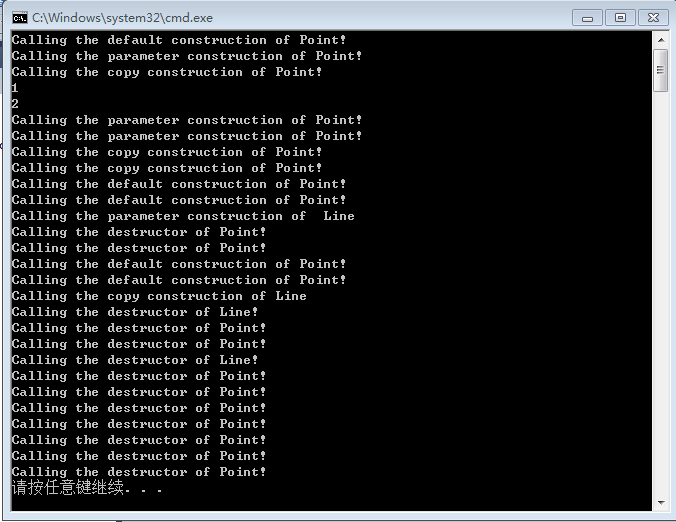1.问题的引入
<span style="font-size:18px;">#include <iostream>
using namespace std;
#include<math.h>
class Point
{
private:
int x; int y;
public:
int getx();
int gety();
Point()
{ cout<<"Calling the default construction of Point!"<<endl; }
Point(int xx, int yy)
{ cout<<"Calling the parameter construction of Point!"<<endl; x = xx; y = yy;}
Point(Point &pt)
{ cout<<"Calling the copy construction of Point!"<<endl; x = pt.x; y = pt.y;}
~Point()
{cout<<"Calling the destructor of Point!"<<endl;}
};
int Point::getx() { return x;}
int Point::gety() { return y;}
//==================================================================
class Line
{
private:
Point dot1,dot2;
double Len;
public:
Line()
{cout<<"Calling the default construction of Line!"<<endl;}
Line(Point pt1, Point pt2)
{
cout<<"Calling the parameter construction of Line"<<endl;
dot1 = pt1; dot2 = pt2;
double Linex = abs( dot1.getx() - dot2.getx() );
double Liney = abs( dot1.gety() - dot2.gety() );
Len = sqrt( Linex*Linex + Liney*Liney);
}
Line(Line &l)
{
cout<<"Calling the copy construction of Line"<<endl;
Len = l.Len;
}
~Line(){ cout<<"Calling the destructor of Line!"<<endl;}
};
void main()
{
Point mypoint1;
Point mypoint2(1,2);
Point mypoint3(mypoint2);
cout<<mypoint2.getx()<<endl;
cout<<mypoint3.gety()<<endl;
Point mypt1(1,2),mypt2(3,4);
Line line1(mypt1,mypt2);
Line line2(line1);
}</span>
2.逐条语句进行分析
<span style="font-size:18px;">Point mypoint1; </span>输出为“Calling the default construction of Point!”
<span style="font-size:18px;">Point mypoint2(1,2);</span>具体行为过程是,在内存中开辟空间定义临时变量 int xx, int yy;通过参数传递,xx = 1. yy = 2;然后在执行含有参数构造函数的函数体,完成临时变量值向Point类的属性x,y的赋值。
输出“Calling the parameter construction of Point!”
<span style="font-size:18px;">Point mypoint3(mypoint2);</span>语句仍然定义了一个Point类的对象,但是应该注意到,这里利用了前一个对象mypoint2对mypoint3进行初始化 。调用了Point类复制构造函数。相当于&pt = mypoint2 。此时,通过看看内存地址,我们可以看到,编译器并没用定义一个Point类的对象临时pt。而是采用了“引用”的模式,pt仅仅是mypoint2的一个别名而已!!!
输出“Calling the copy construction of point!”
<span style="font-size:18px;">cout<<mypoint2.getx()<<endl;
cout<<mypoint3.gety()<<endl;</span><span style="font-size:18px;">Point mypt1(1,2),mypt2(3,4);</span>定义Point类的两个带有初始化参数的对象,
输出“Calling the parameter construction of Point!”
"Calling the parameter construction of Point!"
Line line1(mypt1,mypt2);&pt = mypt2; // “Calling the copy construction of Point!”
&pt = mypt1; // "Calling the copy construction of Point!"
//注意到,此时仍然是引用的格式,没有进行临时对象的构建
line1(mypt1,mypt2); //“Calling the parameter construction of Line!”
重点:当我们利用底层类的对象对上一层类对象进行初始化之后,要立刻销毁底层类的对象,及调用相应的析构函数。
“Calling the destructor of Point!” //销毁对象mypt1
“Calling the destructor of Point!” //销毁对象mypt2
Line line2(line1);&l = line1; //引用传递
“Calling the default construction of Point!”
"Calling the default construction of Point!"
//执行Line复制构造函数的函数体
“Calling the copy construction of Line”
退出程序后,对所有对象进行销毁,其顺序为“与构造函数调用顺序相反”
























 1114
1114

 被折叠的 条评论
为什么被折叠?
被折叠的 条评论
为什么被折叠?








